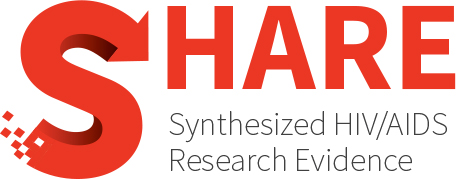Category Archives: Sexual risk behaviour
Factors associated with pregnancy uptake decisions among seropositive HIV people receiving antiretroviral therapy in sub-Saharan Africa: A systematic review
AIM: This study determined the factors associated with pregnancy uptake decision among seropositive HIV people receiving antiretroviral therapy in sub-Saharan Africa. DESIGN: Systematic review. METHODS: The population, intervention, comparison and...
A systematic review of gender-based violence prevention and response interventions for HIV key populations: Female sex workers, men who have sex with men, and people who inject drugs
Gender-based violence (GBV) is that perpetrated based on sex, gender identity, or perceived adherence to socially defined gender norms. This human rights violation is disproportionately experienced by HIV key populations...
Women living with HIV and dual contraceptive use in Ethiopia: Systematic review and meta-analysis
Background Despite different preventive strategies that have been implemented in the country, the prevalence of HIV/AIDS is still significantly increasing in Ethiopia. The concurrence of HIV and unintended pregnancy makes...
A rapid review of disparities in HIV prevention and care outcomes among Hispanic/Latino men who have sex with men in the United States
In the United States, Hispanic/Latino men who have sex with men (HLMSM) are disproportionally affected by HIV. We conducted a rapid review of national surveillance data to examine disparities in...
Barriers and facilitators to acceptability of the female condom in low- and middle-income countries: A systematic review
BACKGROUND: Sexually transmitted infections, including HIV, remain a significant public health challenge for low- and middle-income countries, and about 111 million unintended pregnancies occur in these countries annually. The female...
eHealth interventions to address HIV and other sexually transmitted infections, sexual risk behavior, substance use, and mental ill-health in men who have sex with men: Systematic review and meta-analysis
Background: Men who have sex with men experience disproportionately high levels of HIV and other sexually transmitted infections (STIs), sexual risk behavior, substance use, and mental ill-health. These experiences are interrelated,...
Queering poppers literature: A critical interpretive synthesis of health sciences research on alkyl nitrite use and Canadian policy
BACKGROUND: Poppers (alkyl nitrites) are vasodilators used by many gay, bisexual, and other men who have sex with men (GBMSM) to relieve pain, enhance pleasure, and facilitate penetration during sex....
Risky sexual practice and associated factors among people living with HIV/AIDS receiving antiretroviral therapy in Ethiopia: Systematic review and meta-analysis
BACKGROUND: The risky sexual behavior of people living with HIV/AIDS (PLWHA) may impose a risk of transmitting the disease to their partners and increase Human Immunodeficiency Virus (HIV) co-infection. This...
The association between methamphetamine use and number of sexual partners in men who have sex with men: A systematic review and meta-analysis
BACKGROUND: Methamphetamine use in men who have sex with men population is significantly higher than that in the general population. Meth use can cause high-risk sexual behaviors, such as having...
